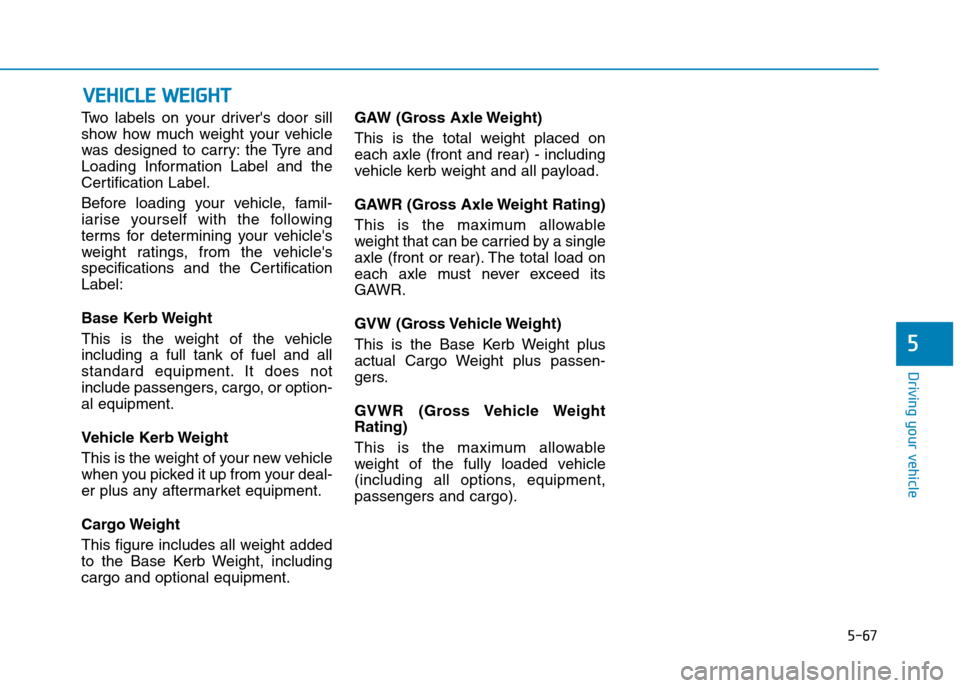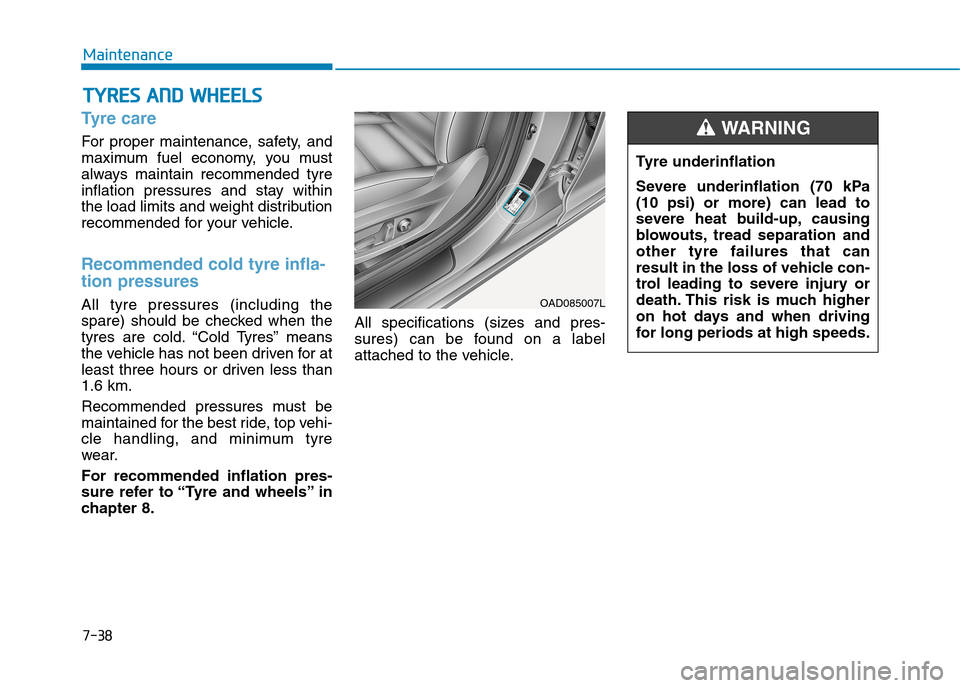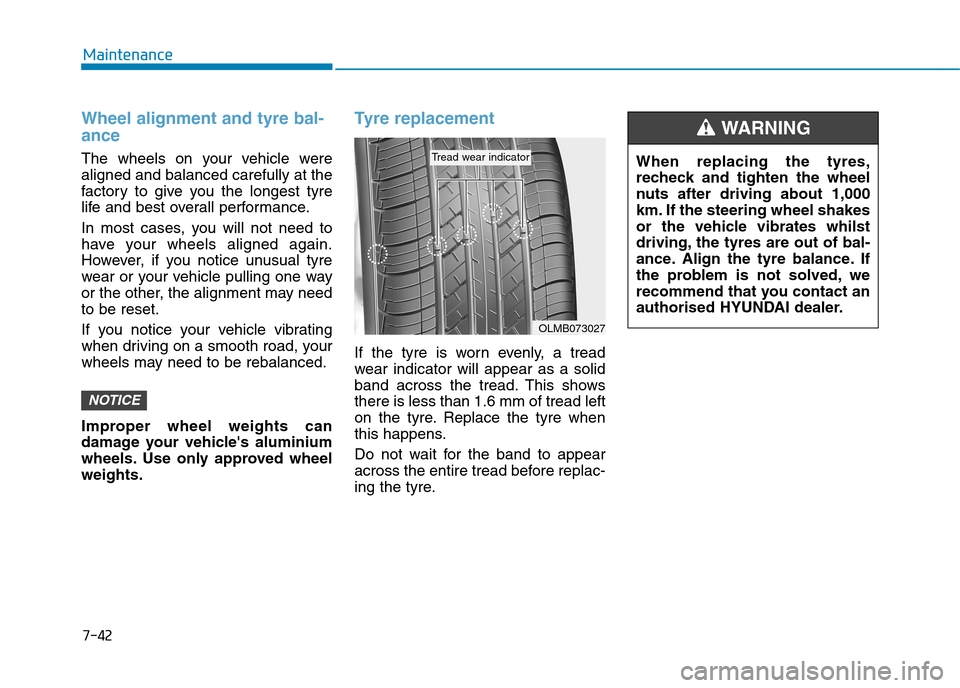Page 443 of 571

5-67
Driving your vehicle
5
Tw o l a b e l s o n y o u r d r i v e r ' s d o o r s i l l
show how much weight your vehicle
was designed to carry: the Tyre and
Loading Information Label and the
Certification Label.
Before loading your vehicle, famil-
iarise yourself with the following
terms for determining your vehicle's
weight ratings, from the vehicle's
specifications and the Certification
Label:
Base Kerb Weight
This is the weight of the vehicle
including a full tank of fuel and all
standard equipment. It does not
include passengers, cargo, or option-
al equipment.
Vehicle Kerb Weight
This is the weight of your new vehicle
when you picked it up from your deal-
er plus any aftermarket equipment.
Cargo Weight
This figure includes all weight added
to the Base Kerb Weight, including
cargo and optional equipment.
GAW (Gross Axle Weight)
This is the total weight placed on
each axle (front and rear) - including
vehicle kerb weight and all payload.
GAWR (Gross Axle Weight Rating)
This is the maximum allowable
weight that can be carried by a single
axle (front or rear). The total load on
each axle must never exceed its
GAWR.
GVW (Gross Vehicle Weight)
This is the Base Kerb Weight plus
actual Cargo Weight plus passen-
gers.
GVWR (Gross Vehicle Weight
Rating)
This is the maximum allowable
weight of the fully loaded vehicle
(including all options, equipment,
passengers and cargo).
VVEEHHIICCLLEE WWEEIIGGHHTT
Page 508 of 571

7-38
Maintenance
TTYYRREESS AANNDD WWHHEEEELLSS
Ty r e c a r e
For proper maintenance, safety, and
maximum fuel economy, you must
always maintain recommended tyre
inflation pressures and stay within
the load limits and weight distribution
recommended for your vehicle.
Recommended cold tyre infla-
tion pressures
All tyre pressures (including the
spare) should be checked when the
tyres are cold. “Cold Tyres” means
the vehicle has not been driven for at
least three hours or driven less than
1.6 km.
Recommended pressures must be
maintained for the best ride, top vehi-
cle handling, and minimum tyre
wear.
For recommended inflation pres-
sure refer to “Tyre and wheels” in
chapter 8.
All specifications (sizes and pres-
sures) can be found on a label
attached to the vehicle.
Ty r e u n d e r i n f l a t i o n
Severe underinflation (70 kPa
(10 psi) or more) can lead to
severe heat build-up, causing
blowouts, tread separation and
other tyre failures that can
result in the loss of vehicle con-
trol leading to severe injury or
death. This risk is much higher
on hot days and when driving
for long periods at high speeds.
WA R N I N G
OAD085007L
Page 512 of 571

7-42
Maintenance
Wheel alignment and tyre bal-
ance
The wheels on your vehicle were
aligned and balanced carefully at the
factor y to give you the longest tyre
life and best overall performance.
In most cases, you will not need to
have your wheels aligned again.
However, if you notice unusual tyre
wear or your vehicle pulling one way
or the other, the alignment may need
to be reset.
If you notice your vehicle vibrating
when driving on a smooth road, your
wheels may need to be rebalanced.
Improper wheel weights can
damage your vehicle's aluminium
wheels. Use only approved wheel
weights.
Ty r e r e p l a c e m e n t
If the tyre is worn evenly, a tread
wear indicator will appear as a solid
band across the tread. This shows
there is less than 1.6 mm of tread left
on the tyre. Replace the tyre when
this happens.
Do not wait for the band to appear
across the entire tread before replac-
ing the tyre.
NOTICE
OLMB073027
Tr e a d w e a r i n d i c a t o rWhen replacing the tyres,
recheck and tighten the wheel
nuts after driving about 1,000
km. If the steering wheel shakes
or the vehicle vibrates whilst
driving, the tyres are out of bal-
ance. Align the tyre balance. If
the problem is not solved, we
recommend that you contact an
authorised HYUNDAI dealer.
WA R N I N G
Page 565 of 571
8-4
Specifications & Consumer information
TTYYRREESS AANNDD WWHHEEEELLSS
Item Tyre sizeWheel
size
Inflation pressure, bar (kPa, psi)Wheel lug nut
torque
kgf•m (lbf•ft, N•m)
Normal load *1Maximum load
Front Rear Front Rear
Full size tyre
195/65 R15 6.0J X 15
2.3 (230, 33) 2.3 (230, 33) 2.3 (230, 33) 2.3 (230, 33)11~13
(79~94, 107~127)
205/55 R16 6.5J X 16
225/45 R17 7.0J X 17
Compact spare tyre
(if equipped)T125/80 D154.0T X 154.2 (420, 60)4.2 (420, 60)4.2 (420, 60)4.2 (420, 60)
When replacing tyres, use the same size originally supplied with the vehicle.
Using tyres of a different size can seriously affect your vehicle's handling.
CAUTION
*1 :Normal load :Up to 3 persons
AAIIRR CCOONNDDIITTIIOONNIINNGG SSYYSSTTEEMM
ItemsWeight of Volume Classification
Refrigerant g (oz.)500±25 (17.6±0.88)R-134a
Compressor lubricantg (oz.)110±10 (3.88±0.35)PA G ( F D 4 6 X G )
Contact an authorised HYUNDAI dealer for more details.
Page 566 of 571
8-5
8
Specifications & Consumer information
TTYYRREE LLOOAADD AANNDD SSPPEEEEDD CCAAPPAACCIITTYY
*1LI : LOAD INDEX*2SS : SPEED SYMBOL
M/T : Manual TransmissionA/T : Automatic Transmission
Item Tyre size Wheel sizeLoad Capacity
LI *1kg
Full size tyre
195/65 R15 6.0J X 15 91 615
205/55 R16 6.5J X 16 91 615
225/45 R177.0J X 1791615
Compact spare tyre (if equipped)T125/80 D154.0T X 1595690
VVOOLLUUMMEE AANNDD WWEEIIGGHHTT
ItemsNu 2.0 MPI
M/TA/T
Gross vehicle weight kg (lbs.)1,800 (3,968)1,820 (4,012)
Luggage volume (VDA)l(cu ft)458 (16.2)